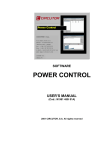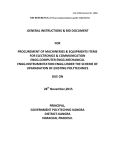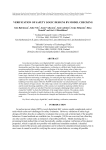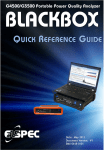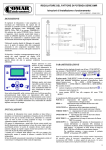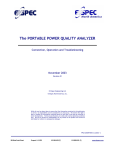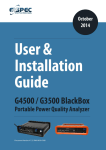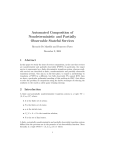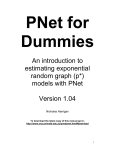Download Manual - Cuthbertson Laird Group
Transcript
G4100 Installation/wiring-1.0.3 Issue 1.1 January 2007 Chapter 7 G4100 Remote Display Unit Installation & Operation Manual International North America Europe Elspec Ltd. Caesarea Industrial Park POB 3019, 4 HaShoham St. Zone 23, Israel 38900 Tel: +972 4 6272 470 Fax: +972 4 6272 465 e-mail: [email protected] Elspec North America Inc. 500 West South Street Freeport, IL 61032 U.S.A. Tel: +1 815 266 4210 Fax: +1 815 266 8910 e-mail: [email protected] Elspec Portugal Lda. Zona Industrial - Fase 1 4900-231 Chafe - Viana do Castelo Portugal Tel: +351 258 351 920 Fax: +351 258 351 607 e-mail: [email protected] Installation & Operation Manual-1.0.3 NOTICE This document contains Elspec proprietary material. The information contained in this document is believed to be reliable and accurate. Elspec assumes no responsibility for the use of this material. The contents of this document are subject to change without prior notice. Elspec PQZip compression technology is patent-pending. Copyright © 2007 Elspec Ltd., ® all rights reserved Elspec™ is a registered Trademark. Important Symbols Used in This Manual: Warning! This symbol indicates instructions that must be followed to avoid device malfunction or damage. Danger! This symbol indicates the presence of dangerous voltage within and outside the product enclosure that may constitute a risk of electric shock, serious injury or death to persons if proper precautions are not followed. This symbol directs the user’s attention to important installation, operating and maintenance instructions. Warranty The Elspec technical support department provides professional and reliable service. All Elspec products are warranted as specified in the terms and conditions warranty. Elspec is not liable for any damages or injuries resulting from equipment misuse and/or unsafe work practices. Installation Considerations Installation and maintenance of the Elspec G1400 Power Quality Data Center should only be performed by qualified, competent personnel that have appropriate training and experience with high voltage and current devices. The meter must be installed in accordance with all Local and National Electrical Codes and regulations. This equipment has no user serviceable parts. 2 Elspec G4100 Remote LCD Display Table of Contents SECTION 1. 1.1 OVERVIEW ................................................................................................................................ 7 SECTION 2. 2.1 2.2 GETTING STARTED ................................................................................................. 9 UNPACKING ............................................................................................................................... 9 SAFETY PRECAUTIONS ...............................................................................................................10 SECTION 3. 3.1 3.2 INTRODUCTION........................................................................................................ 7 HARDWARE DESCRIPTION...................................................................................11 ELSPEC G4100 REMOTE DISPLAY UNIT OVERVIEW ....................................................................11 TECHNICAL AND ENVIRONMENTAL SPECIFICATIONS...................................................................12 3.2.1 3.2.2 PHYSICAL SPECIFICATIONS ............................................................................................................ 12 ENVIRONMENTAL SPECIFICATIONS .................................................................................................. 13 SECTION 4. MOUNTING ...............................................................................................................14 SECTION 5. WIRING ......................................................................................................................15 5.1 5.2 5.3 5.4 5.5 5.6 CONNECTING THE POWER SUPPLY AND LAN .............................................................................15 CONNECTING THE 48V DC TERMINAL .......................................................................................15 POWER OVER ETHERNET (POE) .................................................................................................15 RECOMMENDED MODE OF LAN CONNECTION FOR ELSPEC G4400..............................................15 USB CONNECTION ....................................................................................................................16 RS485/422 ...............................................................................................................................16 SECTION 6. NAVIGATING THROUGH THE SCREENS............................................................17 SECTION 7. BASIC CONFIGURATION .......................................................................................19 7.1 7.2 NETWORK PARAMETERS ...........................................................................................................20 CHANGING THE G4100 IP ADDRESS...........................................................................................21 SECTION 8. USING THE G4100 REMOTE DISPLAY UNIT.......................................................23 8.1 CONNECTING FOR THE FIRST TIME .............................................................................................23 8.2 CONNECTING AND COMMUNICATING .........................................................................................24 8.1.1 8.2.1 8.2.2 8.2.3 ADMIN ACCESS PRIVILEGE ............................................................................................................ 23 CONNECTING A SINGLE G4100 TO A SINGLE G4400 ......................................................................... 24 USING THE G4100 FOR G4400 LAN CONFIGURATION BEFORE INITIALIZATION .................................... 24 USING THE G4100 FOR G4400 CONFIGURATION ACROSS A LAN ........................................................ 27 8.3 AUTOMATIC SEARCH UTILITY ...................................................................................................28 8.4 SETUP MENUS ..........................................................................................................................29 8.3.1 8.4.1 8.4.2 8.5 SECTION 9. ENABLING PQZIP ......................................................................................................................... 34 PQZIP INFORMATION ................................................................................................................... 35 MONITORING ...........................................................................................................37 METERS....................................................................................................................................38 9.1.1 9.1.2 9.2 THE SETUP MENU SCREENS ........................................................................................................... 29 THE SETUP MENU PARAMETERS EXPLAINED .................................................................................... 31 PQZIP SETUP ............................................................................................................................34 8.5.1 8.5.2 9.1 USING THE SEARCH UTILITY .......................................................................................................... 29 METERS- LARGE DIGIT DISPLAY ..................................................................................................... 39 METERS- THE SUMMARY PAGES ..................................................................................................... 40 OSCILLOSCOPE .........................................................................................................................42 3 Installation & Operation Manual-1.0.3 9.2.1 9.3 9.4 9.5 NAVIGATING THE OSCILLOSCOPE .................................................................................................... 43 HARMONICS DISPLAY ...............................................................................................................44 PHASOR DISPLAY ......................................................................................................................45 FLICKER MEASUREMENT ...........................................................................................................46 SECTION 10. TROUBLESHOOTING..............................................................................................48 SECTION 11. TECHNICAL DEFINITIONS ....................................................................................49 SECTION 12. G4400 WEBSITE REFERENCE................................................................................52 List of Figures Figure 1: The Elspec G4400 Basic Module Unit _______________________________________________ 6 Figure 2: The Elspec G4100 Functional Display Unit __________________________________________ 11 Figure 3: The Elspec G4100 Functional Display Unit – Rear View ________________________________ 12 Figure 4: Elspec G4100- Technical Drawing _________________________________________________ 12 Figure 5: Screw Holes for Affixing RDU to a Panel ____________________________________________ 14 Figure 6: Mounting the Remote Display Device to a Panel ______________________________________ 14 Figure 7: Power Over Ethernet PoE Connection ______________________________________________ 16 Figure 8: Terminals for RS485/422 on the Rear Side of the Elspec G4100 RDU ______________________ 16 Figure 9: The Elspec G4100 Main Menu ____________________________________________________ 17 Figure 10: The Elspec Welcome Screen followed by the Connection Configuration Page _______________ 19 Figure 11:The Elspec Search Utility for Finding Elspec Elements on the LAN _______________________ 29 Figure 12: The Two Page Configuration Menu _______________________________________________ 30 Figure 13: The Information Page __________________________________________________________ 31 Figure 14: Read-only "About" Information___________________________________________________ 31 Figure 15: Current trasformer conductor inserted correctly through the Elspec G440 _________________ 33 Figure 16:PT/CT Settings- inputting the Primary PT Value ______________________________________ 33 Figure 17: The Main Menu- Default on Power Up _____________________________________________ 37 Figure 18: Large Digits Display- A Typical Page Layout _______________________________________ 39 Figure 19: The Factors Summary Page: K-factor and Crest Factor _______________________________ 40 Figure 20: Volt/Amp Summary __________________________________________________________ 41 Figure 21: The Power Summary Page ______________________________________________________ 41 Figure 22: The THD Summary Page ________________________________________________________ 42 Figure 23: Waveforms Main Menu _________________________________________________________ 42 Figure 24: Navigating the Oscilloscope _____________________________________________________ 43 Figure 25: A Harmonic Spectrum Screen ____________________________________________________ 45 Figure 26: The Phasor Display ____________________________________________________________ 45 Figure 27: The Flickering Summary ________________________________________________________ 47 Figure 28: A Detailed Flicker Summary _____________________________________________________ 47 4 Elspec G4100 Remote LCD Display Acronyms A Ampere CT Current Transformer DHCP Dynamic Host Configuration Protocol IP Internet Protocol OPC OPen Connectivity (formerly OLE for Process Control), a series of standards specifications PF Power Factor PoE Power over Ethernet PT Potential Transformer RDU Remote Display Unit SCADA Supervisory Control and Data Acquisition SMTP Simple Mail Transfer Protocol SNTP Simple Network Time Protocol SSL Secure Sockets Layer Subnet masking Local Internet subnet masking determined usually by IP admin THD Total Harmonic Distortion 5 Installation & Operation Manual-1.0.3 1 Figure 1: The Elspec G4400 Basic Module Unit 6 Elspec G4100 Remote LCD Display Section 1. Introduction This manual is the last chapter in a series of seven, and will instruct the user in the installation, configuration and use of the Remote Display to monitor and configure any Power Quality Data Center, using a direct connection or through a LAN/WAN The seven chapters comprising the Elspec manual set for the Power Quality Data Center series are listed as follows: 1. Elspec G4400 Power Quality Data Center Installation and Wiring Manual- This manual instructs the user on installing the Power Quality Data Center power meter into an electric panel and how to begin using the Power Quality Data Center. 2. Elspec G4400 Power Quality Data Center Operation Manual- This manual describes the interface for monitoring and configuring the G4400 Power Quality Data Center using the onboard WEB server as it is accessible from a standard web browser from any PC connected to the Internet (or LAN). 3. PQSCADA Site Manager Installation Manual- This manual instructs the user in installing the server based Site Manager Software that will manage the Nodes that will collect, store and analyze the compressed data produced by the G4400 instruments. 4. PQSCADA Site Manager User Manual- This manual instructs the user in setting up the server based Site Manager with Nodes that will collect, store and analyze the compressed data from the G4400 series instruments. The manual instructs the user in surfing to the Site Manager, adding and removing Nodes and operating the Elspec Power Quality Reporting Tool. 5. Investigator Installation Manual- This manual instructs the user in installing the Investigator software used to access, load and analyze data from different G4400 Power Quality Data Centers in order to understand the cause for power quality events that occurred in the system. 6. Investigator User Manual- This manual instructs the user in the use of the Investigator software to load and analyze data from different G4400 Power Quality Data Centers in order to understand the cause for power quality events that occurred in the system. 7. Elspec G4100 Remote Display Installation and Operation Manual- This manual instructs the user in the installation, configuration and use of the Remote Display to monitor and configure any Power Quality Data Center, using a direct connection or through a LAN/WAN. 1.1 Overview The Elspec G4100 Remote Display LCD Unit is an integral part of the Elspec Power Quality Data Center system, allowing interconnectivity with the G4400 series instruments for configuring and monitoring the electrical distribution system. The Elspec G4100 Remote Display Unit (RDU) connects and communicates with the G4400 Power Quality Data Center instrument directly via RJ45 network cable or through IP communication from anywhere in the world. One RDU can be used to monitor and configure many G4400 series instruments. The Elspec G4100 enables configuring all aspects of the G4400 series instruments and displays all monitored real time values. Figure 1 describes the role of the G4100 in managing power quality data in a power distribution system. The G4400 series Power Quality Data Center instrument (1) is connected to the electrical system via current and potential transformers. These instruments constantly record the voltage and current waveforms at a resolution of up to 1024 samples per cycle. This data is compressed on board using 7 Installation & Operation Manual-1.0.3 the Elspec patented PQZip technology. The PQZip files are transferred to a PNode (4) running on a server managed by the Site Manager. The PNode stores the data collected from the instrument and responds to requests from client workstations running Elspec Investigator software (5). When an engineer using the Investigator software wishes to analyze the data collected by the instrument from a certain time frame, the PNode decompresses the requested data, performs the necessary mathematical calculations to display the electrical parameters requested by the client and then arranges and configures the data to be displayed on the specific screen used by the client. Every G4400 instrument hosts an onboard Website allowing access to data from any web browser. Inputting the IP address of the instrument in the address window of an internet browser will bring the G4400 webpage to the browser with current real time monitored values (2). Configuration of the G4400 instrument may also be achieved via the Website. The Elspec IP Address Search Tool (6) is an important element in the Elspec Power Quality Data Center System. This utility allows all G4400 and G4100 units connected to a LAN to be found and identified on line. The G4100 (3) Remote Display LCD is used to both configure and monitor the G4400 series instruments achieving much the same effect as when using a web browser but with the added tactile feed back only a dedicated LCD display can offer. The G4100 can be used as a hand held monitoring and configuring tool connecting to each G4400 instrument in turn using an RJ45 network cable, or optionally plugging into a network connection and alternately inputting the IP addresses of the different instruments. 8 Elspec G4100 Remote LCD Display Section 2. Getting Started 2.1 Unpacking The Elspec G4400 Power Quality Data Center is shipped with the following: # Description Quantity 1 Elspec G4100 LCD Remote Display Unit (RDU) 1 2 LAN cable 1 3 Elspec 4100 Display Installation & Operation Manual 1 4 RS485/422 Communication terminal block connector BL3.5/4/90LF SW- 4p Black Clamping yoke, 1 5 48DC terminal block connector - BL3.5/2/90LF SW – 2p Black Clamping yoke 1 6 Screws for mounting to wall metal plate 2 7 Flat fastening disk for mounting with screws 2 8 Screw-nut 2 Should the contents of the box be damaged or if any of the listed elements are missing please contact your local distributor. 9 Installation & Operation Manual-1.0.3 2.2 Safety precautions Before working with the Elspec G4100, please read this User Manual carefully. The manufacturer will not be responsible for damage or injury due to misuse. The following general safety guidelines apply to Elspec G4100 installation and operation. When performing any operation with the Elspec G4100, always observe these safety precautions. F The instructions contained in this manual are intended for qualified personnel only. To avoid personal injury, do not perform any activity other than as contained herein unless you are qualified to do so. F Before connecting cables to the Elspec G4100, verify that the 48VDC supply is disconnected. F To prevent shock or fire hazard, do not expose the Elspec G4100 to rain or moisture. F Do not make unauthorized modifications to the Elspec G4100. F Always operate the Elspec G4100 within the specified power tolerances. F To use and operate the Elspec G4100, strictly follow the specifications of this manual. The manufacturer will not be responsible for any damage or injury resulting from equipment misuse and/or unsafe work practices. 10 Elspec G4100 Remote LCD Display Section 3. Hardware Description 3.1 Elspec G4100 Remote Display Unit Overview The Elspec G4100 Functional display shown in Figure 2 is can be divided into three conceptual sections. The upper section contains the Status LEDs, the middle section contains the visual interface; a header and the monitor screen and the lower section contains the input interface; 5 Function keys and a Network key. Status LED-s Header Main display F1÷F5 Function keys Network Key Figure 2: The Elspec G4100 Functional Display Unit The Status LEDs indicate as follows: Green LED – External power indication Red LED – Failure or indication of incomplete configuration The Header contains the name of the instrument currently connected and the time of day. The five Function keys are context sensitive, offering dynamic functionality as the unit is used, with the current function appearing above the key. The Network key is used to disconnect with the current instrument, enabling connectivity with another instrument. Figure 3 shows the Elspec G4100 connectors as follows: a. RJ45 – used for both communication & power sourcing the unit (PoE – power over the Ethernet cable coming from Elspec G4400 unit). By factory default the Elspec G4100 unit is ready for connecting to any G4400 unit at the LCD port. A simple CAT5 cable connecting directly between the Elspec G4100 and G4400 LAN2/LCD port will automatically power up, connect and open the main menu screen relevant for that specific G4400 unit currently connected. Remote connectivity (through an IP network) is also applicable but requires configuration as described later in this manual. 11 Installation & Operation Manual-1.0.3 b. DC 48V – Used for alternative power source (for remote connectivity when PoE is not available) c. RS485/422 – Used in industrial applications for multi-drop series communication when IP networking is not available. 48V DC RS485/422 RJ45 Figure 3: The Elspec G4100 Functional Display Unit – Rear View 3.2 Technical and Environmental Specifications 3.2.1 Physical Specifications Figure 4: Elspec G4100- Technical Drawing 12 Elspec G4100 Remote LCD Display 3.2.1.1 Elspec G4100 Remote Display Specifications Dimensions (H×W×D) 197×200×46 mm Panel cutout: 135×135 mm Power supply 48 VDC LAN1 PoE in LED backlight 160×128 pixels graphic screen 3.2.2 Environmental Specifications Intended use Indoor- mounted in a low voltage electrical distribution panel Altitude Up to 2000 meters Operating temperature range -20º to +60º C Maximum relative humidity 95% Power requirements 10 VA Fuse rating 2 A fuse mounted in line with the AC power supply phase wire Installation Category Class III Pollution Degree Degree 2 13 Installation & Operation Manual-1.0.3 Section 4. Mounting The Elspec G4100 remote display unit is designed for mounting on a flat panel through a 138x138mm cutout with two 5mm holes. Two screws are supplied for fixing the display unit to the panel from behind. A typical location for mounting the Elspec Remote Display Unit is on the front panel of an electrical distribution panel. Figure 5 and Figure 6 aid in describing the method of attaching the RDU to a panel. A 138 x138 hole is cut out from the panel and the RDU is slid in to place from in front. The RDU is then fixed in place using two screws from behind. 2 holes for screws Figure 5: Screw Holes for Affixing RDU to a Panel RDU is inserted through the cutout from in front, then bolted in place from behind Figure 6: Mounting the Remote Display Device to a Panel 14 Elspec G4100 Remote LCD Display Section 5. Wiring 5.1 Connecting the Power Supply and LAN The Elspec G4100 requires 48V DC to operate. The unit can receive this power from one of two inputs: 1. 48V DC power input terminal 2. The LAN jack using PoE (Power over Ethernet) from the G4400 instrument labeled LAN2/LCD. When both inputs are in use, the primary source of power is from the 48V DC input terminal, with the PoE offering backup redundancy. 5.2 Connecting the 48V DC Terminal For safely connecting 48V DC follow these instructions: F Ensure the panel under work is de-energized. F Prepare the 48V DC terminal block connector provided with the Elspec G4100 Package F Attach lugged ends of wires to the terminal block using a properly sized screw driver √ The positive wire is to be attached to the terminal marked + √ The negative wire is to be attached to the terminal marked - F Insert the 48VDC terminal block into the socket marked "48V DC" as shown above in Figure 3. The Elspec G4100 Remote Display will operate efficiently using a voltage range from 24-51V DC, however only 48V DC may be used through the PoE input (LAN2/LCD socket on the G4400 instrument). 5.3 Power over Ethernet (PoE) POE is a standard for feeding DC power to an RTU (Remote Terminal Unit) using the network RJ45 cable without the need for additional external power. The Elspec G4100 contains a single LAN port with support for receiving PoE (In) but not for providing PoE (Out) to other devices. To take advantage of the PoE option, connect the RJ45 jack to the port marked "LAN2/LCD" on the Elspec G4400 instrument as shown in Figure 7. 5.4 Recommended Mode of LAN Connection for Elspec G4400 It is suggested that the Elspec G4100 be connected to the port marked LAN2/LCD on the Elspec G4400 and that the LAN1 port on the G4400 be used to connect to the LAN for communicating PQZip files to the Node on the power quality server. 15 Installation & Operation Manual-1.0.3 Figure 7: Power Over Ethernet PoE Connection 5.5 USB Connection Follow accepted USB protocol connection procedures. 5.6 RS485/422 The RS485/422 serial communications hardware protocol is an industrial standard using 2 or 4 wires for communication. The wires are to be connected to the terminals marked RS485/422 on the Elspec G4100 RDU as shown in Figure 8 and to the marked terminals on the CPU module of the Elspec G4400 instrument. Figure 8: Terminals for RS485/422 on the Rear Side of the Elspec G4100 RDU To enable understanding of the protocol for the purpose of enabling efficient communication, basic elements of the protocol are described here: √ Voltage is typically 5V DC √ Cable is comprised of 2 shielded twisted pairs √ Typical length of cable is < 1000 meter with no repeater √ Units are connected in multi-drop (“daisy chain”) configuration. In 2 wire mode, the wires coming in and going out share the same terminal on the instrument √ Shield MUST be grounded, but ONLY at one point in the chain. 16 Elspec G4100 Remote LCD Display Section 6. Navigating Through the Screens All Elspec G4100 Remote Display Unit functions are accessible through the 5 function keys located at the bottom of the panel. These function keys are context sensitive and will change functions depending on the screen being viewed. The function performed by the key at any time will be displayed on the Function Key Tag immediately above the function key. Figure 9: The Elspec G4100 Main Menu Figure 9 presents the Main Menu. The chapters of the menu are displayed graphically in the center of the display and described textually just above the function key tags. Navigation is achieved by pressing the function key under the arrows. Entering a chapter is accomplished by pressing the key under the screens: (F3) symbol. The G4100 Remote Display Unit displays three distinct types of • Numeric Display- This type of display emulates an electrical panel power meter display comprising three rows of electrical parameters presented in large digits. Clicking on the appropriate function key toggles through all the electrical parameters and pages of electrical parameter summaries • Graphic Display- This type of display is used to present waveforms, phasors and harmonics • Text Display- This type of display is use to display textual information such as reports, alarms and warnings Favorites List The Favorites list contains monitored parameters often accessed by the operator. The Favorite parameters most interesting an operator are easily toggled through the F5 key from any 17 Installation & Operation Manual-1.0.3 measurement screen displaying electrical parameters, as opposed to going back to the previous menu and entering the next page of parameters. Menu Key The F4 key is used to get to the main menu from any of the display modes. Help Function The Help function is activated by pressing the F1 key where ever the help function is relevant. Cancel and Back Functions In order to activate the CANCEL and BACK Functions, use the F2 key. CANCEL will close the menu and will return to the previous display mode, while BACK will close the current submenu and return to the previous menu. Enter, Next, Select and Close Functions The F3 key is used for ENTER, NEXT, SELECT or CLOSE. All these functions accept the entered information. ENTER is also used to open a submenu and to select a menu item. At the Installation Wizard, NEXT will accept the entered data and move to the next screen. SELECT will toggle between the selected inputs, and CLOSE will accept data and close the page. UP and DOWN Functions (up) and (down) functions. When in a Large In most screens the F4 and F5 keys activate the Digit screen (see section 9.1.1 on page 39), the Down key will toggle through the "Favorites List". At the data entry windows, the (up) button will increment the value by 1, while the (down) button will decrement the value by 1. Holding the button down continuously will change the value in steps of 10. At all other windows, line down. 18 (up) will move the selection bar one line up and (down) will move it one Elspec G4100 Remote LCD Display Section 7. Basic Configuration When powered up after being installed into an electrical panel, or powered up by being connected to the Elspec G4400 instrument via the LAN2/LCD socket, the G4100 is ready to be configured before being used to configure, set up and monitor a G4400 instrument. When the LAN and power cables are first connected, the device boots up, first showing the Elspec welcome screen and then arriving at the Connection Configuration page shown in Figure 10, from where the G4100 RDU can be configured. After a few seconds (configurable- see below "Auto connect page"), the page changes to the Elspec G4400 Main entry menu page, from where the Elspec G4400 instrument is to be configured (Figure 9). To return to the G4100 configuration page, simply push the Network Key or use the right arrow ( ) and left arrow ( ) to navigate to and select the Log Off option, that will return to the 'Connection Configuration' page. Figure 10: The Elspec Welcome Screen followed by the Connection Configuration Page As seen from Figure 10, the Connection Configuration screen displays the following headings: • IP address: This heading displays the last G4400 instrument to which the G4100 RDU was connected. Entering here allows the user to connect to any G4400 instrument on the network. • Password: The default password is 123. An administration password is supplied separately by Elspec. From this heading, the administrator may input his password and freely change parameters on the G4400 instrument being configured until he presses the Network key or the keypad is idle for 5 minutes. There is no need for any password to change the parameters of the G4100 RDU from these pages. • Language: From this screen the user chooses the interface language. • Configuration: Navigate to this heading using the F4 and F5 keys in order to configure the G4100 Remote Display Unit with the following options: √ General information- this screen offers the serial number and version information for all software resident in the G4100 RDU √ Auto connect configuration- In this page the time for presenting the Connection Configuration page is set. After this time, the G4100 will automatically connect to the last G4400 instrument to which it was connected. √ LCD Contrast- the contrast ratio between black and white for the LCD is set in this screen √ LCD Backlight timeout- this screen allows for setting a time until the backlight extinguishes automatically 19 Installation & Operation Manual-1.0.3 √ Network configuration- this screen is used to configure the network parameters for the G4100 Remote Display Unit in order that it may be plugged into the LAN/WAN and communicate with any G4400 anywhere in the world. The parameters that must be configured are as follows (these parameters are explained in section 7.1- Network Parameters- Table 1): ◊ DHCP- This value may be toggled ON or OFF. If this parameter is toggled on, then the IP address, Subnet mask and Gateway can not be configured manually. The G4100 RDU is factory set with the DHCP set to off, and the network parameters set as defined in the following sections. ◊ IP address: The factory default address for the G4100 RDU is 192.168.168.100 ◊ Subnet mask: The factory default subnet mask for the G4100 is 255.255.255.0 ◊ Gateway: The factory default Gateway for the G4100 is 192.168.168.168 (which is the default address for the G4400 LAN2/LCD port. ◊ NTP address: this is the address for taking the UTC. ◊ SMTP address- in the event that this parameter is used by the system. √ Firmware upgrade- the G4100 firmware can be updated from this screen by using the following sub menus: ◊ FTP address- input the FTP address from where the firmware is to be downloaded ◊ FTP login- input the user name required to enter and download from the FTP site ◊ FTP password- input the password required to enter and download from the FTP site ◊ FW filename- input the filename to be downloaded from the site These procedures will be described and explained in the following sections. 7.1 Network Parameters This section will explain the Network Parameters necessary to enable the configuring and monitoring of the G4400 Power Quality Data Center using the G4100 Remote Display Unit. The network parameters are defined in Table 1. Table 1: Network Parameters No User network parameter Definition 1 DHCP Status toggle DHCP – Dynamic Host Configuration Protocol. Elspec enables 2 run modes: DHCP enable and disable. DHCP enabled: The G4400 network configuration is automated by the Internet server, the G4400 will not keep user input network parameters; rather the Internet server configures the network parameters automatically. DHCP disabled: The G4400 network parameters are input by the user, and remain static Parameters affecting DHCP disabled 2 IP address Internet address of the Elspec G4400 device. Configuring an IP Address for Elspec G4100 – refer to section 7.2 3 Subnet Mask A local bit mask (set of flags) that specifies which bits of the IP address specify a 20 Elspec G4100 Remote LCD Display particular IP network or a host within a sub-network. An IP address of 128.66.12.1 with a subnet mask of 255.255.255.0 specifies host 1 on subnet.128.66.12.0 The subnet mask determines the maximum number of hosts on a sub-network 4 Gateway A Gateway is a computing node on the local Internet network that allows or controls access to that network. 5 SNTP address SNTP – Simple Network Time Protocol. A PC server or an Elspec G4400 device can be used as a time reference (UTC). SNTP is a protocol used to reference that time to the local machine. Example: An Elspec G4400 device with IP address 100.100.100.69 is configured as the NTP address. The Elspec G4400 that is being configured by the Elspec G4100 device is IP address 100.100.100.63. The configured device will relate to 100.100.100.69 as the reference UTC server clock. That clock is essential to the generation of coherent PQZIP files. 6 SMTP address SMTP - Simple Mail Transfer Protocol. Currently not in use. A protocol which controls the transfer of e-mail messages between two mail servers. Table 2, shown below, presents the factory default values for the G4400 instrument and the G4100 RDU. Table 2: Factory Default Network Parameters 7.2 No Parameter G4100 G4400 LAN2/LCD G4400 LAN1 1 DHCP Status toggle OFF OFF ON 2 IP address 192.168.168.100 192.168.168.168 169.254.249.247 3 Subnet Mask 255.255.255.0 255.255.255.0 255.255.0.0 4 Gateway 192.168.168.168 169.254.249.254 169.254.249.254 Changing the G4100 IP Address Changing the IP address of the G4100 RDU is necessary to connect to a network in order to enable connection to one or more G4400 instruments via the network. Changing the IP address of the G4100 RDU will disable direct communication via the LAN2/RDU port on the G4400 instrument. To re-enable this direct communication requires changing the IP address of the G4100 RDU back to the factory default of 192.168.168.100 with subnet mask 255.255.255.0 Navigate to the 'Connection Configuration' page, shown in Figure 10 on page 19, by pressing on the Network key or logging off from the main menu: F Navigate to the "Configuration" chapter and press enter F Navigate to the Network Configuration and press enter F Select 'DHCP status toggle' and ensure that the DHCP is disabled. If DHCP is not disabled, then any change to the network IP address will not stay. F If the screen asks: "Do you want to enable DHCP?" press X; if the screen asks "Do you want to disable DHCP?" press OK. 21 Installation & Operation Manual-1.0.3 F Select 'IP address' and the following screen will appear: Navigate between the 4 address elements using the right arrow. Change the address elements using the up and down arrows. Lock in the address by pushing the OK button. F Select 'Subnet mask' and change as necessary using the right, up and down arrows F Select the 'Gateway' and change as necessary using the right, up and down arrows 22 Elspec G4100 Remote LCD Display Section 8. Using the G4100 Remote Display Unit After the Elspec 4100 Remote Display Unit has been configured, it may be used to configure and display the measured parameters of the Elspec G4400 Power Quality Data Center instrument. One RDU can be used to configure and monitor a number of G4400 instruments by changing the IP address of the instrument to be monitored. The setup and configuration procedure of the G4400 instrument includes: • G4400 Unit setup: √ Administration authorization √ Site name √ Operator name √ Site description. • Electrical system parameters: √ Phase configuration (Y, ∆) √ Nominal values (V, I, f) √ CT/PT ratios (Configuring these parameters must not precede the configuration of the Nominal values) √ Polarity of input waveforms (normal/reverse) • Network setup √ Assign IP address √ other internet relevant configuration parameters • Firmware upgrade These procedures will be described and explained in the following sections. 8.1 Connecting for the First Time Connecting to the Elspec G4400 Power Quality Data Center with the Elspec G4100 Remote Display Unit is accomplished differently depending on the manner in which the connection is made, and the purpose of the connection. Connecting a G4100 RDU as a static display for a single G4400 instrument requires less configuration than connecting a single G4100 unit to multiple G4400 instruments over the internet, though this configuration is not overly complicated requiring only a basic understanding of IP addressing and system parameters from the LAN administrator. When attempting to make changes to the G4400 configuration, the user will be asked to enter an administrative password. 8.1.1 Admin Access Privilege Modifying setup parameters requires administrative or Admin authorization. When the user attempts to modify the first parameter, an access level modification page will appear: 23 Installation & Operation Manual-1.0.3 Pressing on X will return to the previous menu, pressing OK will bring up the Admin authorization page: Delete the default user password, 123, by navigating to the "Del" key and pressing SELECT three times. Enter the password supplied by Elspec to authorize Admin level access by using the arrows to navigate to each character of the password and pressing SELECT. When the whole password is displayed on the screen, press OK. The previous configuration screen will appear, with "write" authorization. 8.2 Connecting and Communicating 8.2.1 Connecting a Single G4100 to a Single G4400 If the G4100 RDU is to be used as a permanent display for a single G4400 instrument, the connection is made simply from the G4100 port to the G4400 LAN2/LCD port using a regular LAN Cat5 cable with RJ45 plugs on both ends. No configuring is necessary; the communication is "plug and play". Both the G4400 and the G4100 are factory programmed with default IP addresses and subnet masks to enable immediate communication between them. These default values are listed in Table 1 on page 20. 8.2.2 Using the G4100 for G4400 LAN Configuration Before Initialization If the G4100 is to be used to configure a G4400 instrument offline before connecting to a LAN, the factory defaults can be used to enhance the communication configuration task. F Before allowing connection to the LAN, connect the G4100 RDU to the LAN2/LCD port on the G4400 instrument 24 Elspec G4100 Remote LCD Display F Due to the plug and play feature, the Main menu appears allowing configuration of all G4400 parameters including the network parameters: F Navigate to System configuration using right ( then ) and left ( (select-F3): F Navigate to System information (i) using right ( then ) and left ( )and (select-F3): F Navigate to Network information using the then ) and (up) and (down) and (select-F3): 25 Installation & Operation Manual-1.0.3 F Navigate to DHCP status toggle using the then (up) and (down) and (select-F3): The following screen appears: F Press F3 (OK) to disable DHCP. This is in order to allow the configuring of prepared and previously mapped IP addresses manually in the following steps. If the DHCP is not disabled, the manually input address will not remain, since the enabled DHCP will allocate random IP addresses, subnet masks, and gateways. F Navigate to the IP address using the then F Use the right ( (up) and (down) and (select-F3): ) to navigate between the groups and the (up) and (down) to increase and decrease the value of the group. Press OK (F3) when the IP address is complete. 26 Elspec G4100 Remote LCD Display F Repeat the previous steps for the Subnet mask and the Gateway. When the IP address, subnet mask and gateway are configured, the G4400 instrument can be connected to the network from the LAN1 port, and the G4100 RDU can be used from any network port to communicate, monitor and configure the G4400 via the LAN1 port now configured and mapped by the administrator. 8.2.3 Using the G4100 for G4400 Configuration across a LAN If a number of G4400 instruments are installed and connected to the LAN before Network parameters are configured, the Network Server will automatically allocate IP addresses, subnet masks and gateways to these instruments, since the G4400 instrument ships from the factory with DHCP enabled. In order to configure and monitor the G4400 instrument using the G4100 RDU across a LAN, the IP address for the G4400 must be input to the RDU. Since the Network Server randomly allocated addresses to each G4400 instrument, the IP address for the G4400 instrument may not be readily available. For this purpose, Elspec supplies an Automatic Search Utility to find and list all Elspec devices, G4100 and G4400, across a LAN. The Automatic Search Utility is described in section 8.3 on page 28. Once a list of G4400 instruments is compiled, it is possible to plug the G4100 RDU into a network port and to configure and monitor these instruments one by one as follows: F Change the IP address of the G4100 by following the directions in section 7.2 on page 21. F Press on the Network Key to arrive at the Connection Configuration screen: F Navigate to the IP address Field and press Enter. A list of previously visited G4400 instruments will appear: 27 Installation & Operation Manual-1.0.3 F One of the displayed instruments can be chosen by navigating to the instrument and pressing Select, or a new instrument can be added by pressing ADD: F Input the new IP address using the right arrow to move between groups and the up and down arrows to increment and decrement the value of the group. F Press OK and the 'Add a Name' screen appears: F Input a name by choosing letters via the left and right arrows for navigation and the Select (F1) key for inserting. When the name is complete, press OK (F3) F After pressing OK, the instrument list appears again with the new added instrument. Navigate to the new instrument and press on Select (F3). F The Connection configuration Screen appears again, navigate to 'connect' and press Enter (F3). The G4100 RDU and the G4400 instrument are now communicating and configuration and monitoring of the G4400 can continue. 8.3 Automatic Search Utility One of the applications of the Elspec G4100 Remote Display Unit is to plug into a network outlet in a LAN and to communicate with any G4400 instrument on the network. It could come to pass that the IP addresses for one or more of the G4400 instruments may become unknown. Since knowing the address of the target G4400 instrument is necessary for communicating with the instrument, Elspec supplies a PC search utility that automatically finds Elspec G4400 and G4100 instruments on the LAN. 28 Elspec G4100 Remote LCD Display The utility is an executable file requiring no installation named: "ElspecSearch.exe" and connects through WEB browser or FTP. The utility is located on the CD packaged with the Elspec G4400 instrument and can also be downloaded from the Elspec site at: http://www.elspec-ltd.com/eg4ksearch. A simple double click on the file name launches the utility. Figure 11 shows the user interface. Functionality includes: • Search • Refresh • Export to Excel spread sheet Figure 11:The Elspec Search Utility for Finding Elspec Elements on the LAN The Utility broadcasts "Discovery" transmissions over the LAN to which every unit responds with its configuration. The search can not extend beyond the LAN area. The broadcast will extend across most hubs and switches, but will not pass gateways, routers or firewalls. 8.3.1 Using the Search Utility After copying the utility from the CD or downloading from the Elspec site, double click on the file name (or tool icon if the program was equipped with one). 1. From the File menu, select "Refresh List" to identify all device IPs on the network 2. From the Mode menu, choose between AutoRefresh ON and OFF. 8.4 Setup Menus This section will describe the various Menus necessary to configure the electrical parameters of the Elspec G4400 Power Quality Data Center. The first section will introduce the menu structure after which the parameters will be explained. 8.4.1 The Setup Menu Screens This section will describe the setup menus. From the main menu: 29 Installation & Operation Manual-1.0.3 Press on the to enter the Configuration sub menu: This screen offers two menus, the is the configuration menu and the (i) is an information menu. Press on the once more to enter the 2 page Configuration menu: Figure 12: The Two Page Configuration Menu Press on the (i) to enter the information menu as displayed in Figure 13. The Information page allows unlimited access to read the parameters configured in the previous menu with out requiring an administrative password. The Information pages are equipped with an Edit button allowing parameter changes to be made from this Information page with out having to exit the page and entering the Configuration page. Pushing the Edit button in the Information mode will, however, trigger the access level modification page. 30 Elspec G4100 Remote LCD Display Figure 13: The Information Page All the pages available for viewing from the Information page are configured in the configuration menu except for one page- General Information. This page displays the version numbers for the elements of the G4400 instrument as shown in Figure 14. Figure 14: Read-only "About" Information 8.4.2 The Setup Menu Parameters Explained • Site Setup: This page is used to define the site where the instrument is installed. Information available for input includes: √ Site name √ Operator name √ Site description 31 Installation & Operation Manual-1.0.3 • Power Configuration: This page is used to input the type of electrical distribution system. The configurations available include: √ Single line-neutral √ WYE 4 wires √ Single line-line √ Delta (WYE) 3 wires These wiring configurations are explained in the manual accompanying the Elspec G4400 Power Quality Data Center. • Display Formats: This page allows the user to configure the terminology used by the G4400 instrument to fit local terminology. The interface supports changing between naming conventions for naming phases and describing reactive behavior: √ Phase nomenclature: ◊ 123 ◊ ABC ◊ RST ◊ XYZ ◊ RYB ◊ RWB √ Reactive behavior: ◊ Cap/Ind (Capacitive or Inductive) ◊ LD/LG (Lead or Lag) • Polarity Configuration: This page allows for the mathematical (software) reversal of the current flow through the Elspec G4400 series instrument. Both current direction and voltage polarity is a matter of importance in measuring electrical parameters. The Elspec G4400 series instrument must be installed properly with the current transformer wires directed correctly through the instrument as shown in Figure 15. When this is not the case, it is possible to configure the instrument through the software to reverse the direction mathematically. The user can identify instances where the polarity is not acceptable through the following signs: √ The power factor deviates strongly from the expected range √ Negative power factors coexist with positive power factors dispersed between the three phases √ Values for one phase or more are exceptionally low √ The phasor diagrams for voltage are not the anticipated 0º, 120º and 240º 32 Elspec G4100 Remote LCD Display Arrow indicating correct current wiring direction Normal polarity + Figure 15: Current trasformer conductor inserted correctly through the Elspec G440 • Nominal values: This page allows the user to input the nominal values necessary for internal calculations and for comparison purposes in calculating power quality compliance to the EN50160 standard. Nominal values are to be input only after configuring PT/CT ratios. The nominal values to be input are: √ Frequency- 50 or 60 Hz √ Voltage- Phase to phase value √ Current- Phase to neutral • PT/CT Configuration: This page accepts the required transformation values for measuring the electrical system. The Elspec G4400 series instruments can monitor all AC voltages and all currents. This is achieved by using measuring transformers. The CT or Current Transformer is comprised of a coil fitted around the current carrying conductor with the secondary conductors designed to carry no more than 5 amperes (in some cases 1 ampere secondary conductors are used). A CT designed for a 500A load with a 5A secondary will have a CT ratio of 500:5. The PT or Potential Transformer operates under a parallel methodology; a voltage transformer is designed to transform the rated network voltage to a secondary output with a typical value of 110V. For example, a PT for a 22000V network will have a PT ratio of 22000:110. Figure 15 illustrates the interface. Each value has a separate page. PT phase primary is input on its own page, as is the PT phase secondary. The Elspec G4400 supports different inputs for the phase and for the neutral lines. Figure 16:PT/CT Settings- inputting the Primary PT Value NOTE: When the PT/CT ratio is modified, the Elspec G4400 automatically recalculates the nominal values for voltage and current and replaces the existing values. Therefore, nominal values must be input only after PT/CT values. • Reset counters: The Espec G4400 instrument stores extreme values for selected parameters. This page allows the user to reset these values. The parameters for resetting are: 33 Installation & Operation Manual-1.0.3 √ Current and voltage Min/Max √ Flickering Min/Max √ Energy demand √ Energy √ Compliance (EN50160) √ System event logger (not recommended) 8.5 • Network Setup: This page is used to define the network parameters. The relevant network parameters are explained in Table 1 on page 20. When entering a "warm" G4100, the network parameters referred to are those of the LAN1 socket of the G4400 instrument to which it is connected. For more on accessing and configuring both the G4100 RDU and the G4400 instrument, go to 7.2 and 8.2Error! Reference source not found. respectively. • Auto connect page: This parameter is the time it takes for the G4100 to switch automatically from the 'Connection Configuration' page where network parameters for the RDU itself may be configured (see Section 7) to the Network Menu, where the network parameters for the last connected G4400 instrument are changed (see Section8.2). • Auto logoff configuration: This parameter sets the time to log off automatically after the last button was pushed. • Password configuration: This is where the access control takes place, allowing modification to viewer, user and admin passwords. • Set demand and energy intervals: This page allows the user to determine the demand and energy demand intervals. • Set metering energy time: Not currently in use. • Set time zone: The user must input the local offset to UTC (Greenwich Mean Time). • Set regional settings: Not currently in use. • Set averaging intervals: This parameter allows the user to input an interval time for averaging the RMS values that appear on the screen, this is to avoid an illegible display due to overly frequent display update. Default value is 30 seconds. • Firmware update: This submenu enables updating firmware of the G4400 instruments. PQZip Setup PQZip is the Elspec patent that enables total power quality information. Instead of proactively setting triggers to capture and photograph the waveform of a power quality event that may or may not happen again, and may or may not be of the expected magnitude according to which the trigger was set, PQZip enables the Elspec G4400 Power Quality Data Center to constantly record the waveform at a high resolution. This is possible due to the high compression ratio achieved by PQZip. Depending on the electrical system being monitored, compression ratios as high as 1:1000 and even 1:10000 are achieved. 8.5.1 Enabling PQZip After all electrical system and communication network parameters have been configured it is necessary to enable the PQZip compression software before the instrument begins recording. With out enabling PQZip, the instrument monitors but does not record. To enable PQZip, navigate to the PQZip button on the main menu: 34 Elspec G4100 Remote LCD Display Press the button and arrive at the PQZip main menu: Navigate to PQZip enable/disable and press on Press the button: Press OK to enable/disable PQZip. 8.5.2 PQZip Information The PQZip information page is read only and offers pertinent information on the current status of PQZip. The page is reached by choosing "Information" from the PQZip Main Menu shown above in section 8.5.1 and pressing on the button. The Information page appears: 35 Installation & Operation Manual-1.0.3 The following information is offered by the Information menu • PQZip State: enable/disable • Free Disk Space: this refers to the free disk space available on the G4400 instrument • Compression Mode: there are two modes of compression: √ Fixed quality- the resolution is set according to the accuracy desired; this being a function of the measuring accessories. If the CTs and PTs are of a specific accuracy, it is not necessary to save to the highest resolution. √ Fixed rate- in this mode, the user sets the amount of memory to be used per unit time, and the instrument sets the resolution accordingly 36 • Current Session: Debugging information • Current File name: the name of he file currently being written by PQZip • Current Tolerance: This is the percentage of data compression Elspec G4100 Remote LCD Display Section 9. Monitoring The Elspec G4100 Remote Display is used for configuring and monitoring the Elspec G4400 instrument. This section will describe and instruct on monitoring the G4400 Power Quality Data Center using the G4100 RDU. The default start up menu when powering up the G4100 RDU is the Main Menu shown in Figure 17. This menu is comprised of icons pointing to the monitoring and configuration sub menus. Navigation between the icons is accomplished using the navigation buttons as explained in Section 6 on page 17. When an icon is reached using the navigation buttons, an explanatory description appears just above the function key tabs. For example, in Figure 17, the first icon from the upper left is activated, and its name, "System Configuration" appears above the function key tabs. Table 3 explains each icon and what it accesses. The following sections will describe the monitoring screens. Figure 17: The Main Menu- Default on Power Up Table 3: Main Menu Icon Key Icon Menu Name Functionality System configuration Enter the configuration sub menus. See 8.4.1 on page 29 Meters Enter the metering sub menus: Voltage, current, powers, and other electrical parameters of interest Oscilloscope Enter the voltage and current waveform sub menu Harmonics display Enter the voltage and current harmonics sub menu Phasors display Enter the voltage and current phasor page 37 Installation & Operation Manual-1.0.3 Icon 9.1 Menu Name Functionality Energy measurement Enter the Energy sub menu PQZip Information Enter the PQZIP sub menu Flickering information Enter the Flicker-meter sub menu Logoff Logoff from the Main menu Meters This menu, when entered, is labeled the Large Digits Menu and lists the displays available for presentation on the G4100 Remote Display Unit. These displays are the real time RMS values of measured parameters that are required by electricians and engineers on a day to day basis. Upon entering the Meters icon, the following menu appears: The pages available are explained as follows: No. Sub menu name Functionality 1 Power Totals Displays the sum of 3 phases: Active, Reactive and Apparent powers 2 Volt-Ampere-PF Displays an average of the 3 phases for voltage and current, and system PF 3 Line-to-Line voltages Displays phase to phase voltages 4 Line currents Displays phase currents 5 Factors summary Displays crest and K factors 6 Volt/Ampere summary Displays a page of voltage and current values including: L-L and L-N voltages, Neutral-Ground voltage, Unbalanced voltage(%), Current, Average of phase currents, Neutral current, Unbalanced current(%), Phase order and Frequency 7 Power summary Displays a page of power values including phase and total values for Active, Reactive and Apparent power, as well as Power Factor for each phase and the system (average) power factor 38 Elspec G4100 Remote LCD Display No. Sub menu name Functionality 8 THD summary Displays THD values for each phase in voltage (L-L and L-N) and current, as well as THD values for the neutral conductor 9.1.1 Meters- Large Digit Display A typical Large Digits page is arranged to display pertinent data for the selected electrical parameter in an efficient manner. Figure 18 represents an example of the Large Digits display, in this case Line to Line voltages are displayed. This type of display is used for most of the Meter menu and much of the Energy Measurement menu. Table 4 explains the various displayed fields. The Down arrow- F5- will toggle the other Large Digit pages, producing the Favorite list. 3 2 4 1 5 Figure 18: Large Digits Display- A Typical Page Layout Table 4: Displayed Page Elements No. Element 1 The Parameter being measured 2 Measured value 3 Units of the measured value 4 Minimum and Maximum values 5 Toggle between empirical and % Per Unit Values Table 4 is further explained as follows: 1. This field is used in the following pages for these measured parameters: √ Power Totals show: ◊ Apparent power in KVA or PU ◊ Active power in KW or PU ◊ Reactive power in KVAr or PU √ Volt-Ampere-PF shows: ◊ The average voltage of the three phases in volts or PU 39 Installation & Operation Manual-1.0.3 ◊ The average current of the three phases in amperes or PU ◊ The System or average power factor with Lag/Lead (Cap/Ind) √ Line to Line Voltage shows: ◊ Voltage L1/L2 in volts or PU ◊ Voltage L2/L3 in volts or PU ◊ Voltage L3/L1 in volts or PU √ Line Currents show: ◊ Current Line 1 in amperes or PU ◊ Current Line 2 in amperes or PU ◊ Current Line 3 in amperes or PU 2. This is the Large Digit- the actual measured real time RMS value. In fact, the value displayed is an average of previous number of measurements. Since the G4400 calculates the RMS value for each cycle, it is not practical to display every value measured. The amount of cycles averaged for display is configurable. 3. The measured value is displayed along with the element measured, for example line to line voltage as opposed to line to neutral voltage or line current. 4. Extreme values- minimum and maximum values- are constantly replaced as new values are generated. These values will continue to increase or decrease until they are reset by the user. 5. This key (F1) is used to toggle between the actual empirical measured value, volts or amperes, for example, and Per Unit values. The PU value is the percentage of the base value defined by the Nominal Values input as explained in section 8.4.2. 9.1.2 Meters- The Summary Pages The last 4 meters listed on the Large Digits meter page are summaries. The following figures display the screens in the order of their appearance. Figure 19: The Factors Summary Page: K-factor and Crest Factor 40 Elspec G4100 Remote LCD Display Figure 20: Volt/Amp Summary Figure 21: The Power Summary Page 41 Installation & Operation Manual-1.0.3 Figure 22: The THD Summary Page 9.2 Oscilloscope The Oscilloscope page allows the user to see the real time current and voltage wave forms. Upon entering the Waveforms Main Menu, as shown in Figure 23, the user can select to view current, voltage or both current and voltage waveforms together on the same screen. Figure 23: Waveforms Main Menu From the Waveforms Main Menu the submenus are: • Current waveforms √ L1 Current waveform √ L2 Current waveform √ L3 Current waveform √ L1+L2+L3 Current waveforms • Voltage waveforms √ L1 Voltage waveform 42 Elspec G4100 Remote LCD Display √ L2 Voltage waveform √ L3 Voltage waveform √ L1+L2+L3 Voltage waveforms √ L1-L2 Voltage waveform √ L2-L3 Voltage waveform √ L3-L1 Voltage waveform √ L12+L23+L31 Voltages • Voltage + Current waveforms √ L1 voltage + current √ L2 voltage + current √ L3 voltage + current √ Neutral voltage + current 9.2.1 Navigating the Oscilloscope The Oscilloscope screen shown in Figure 24 as an example for navigating the screen is the L1 voltage + current page. 2 3 1 4 Figure 24: Navigating the Oscilloscope No. Element 1 These are the values of the voltage and current at the position ruler (#2) 2 The position ruler; allows observation of simultaneous voltage and current. The ruler is moved left and right using the F4 and F5 arrows. The ruler remains in the same position when moving from screen to screen. 3 The position in degrees from the origin of the sine cycle 4 Pushing on the magnifying glass key increases the cycles presented in the screen. x4 implies 4 cycles presented in the screen. 43 Installation & Operation Manual-1.0.3 9.3 Harmonics Display The Harmonics Display allows the user to examine the harmonic breakdown of each measured waveform. From the Main menu, navigate to the harmonics icon and press Enter: From this submenu, the Current harmonic spectrums that may be chosen are: √ L1 current √ L2 current √ L3 current The Voltage harmonic spectrums that may be chosen are: √ L1-L2 voltage √ L2-L3 voltage √ L3-L1 voltage √ L1 voltage √ L2 voltage √ L3 voltage Figure 25 models a typical Harmonics Analysis screen as it is described in the table below. No. Element 1 These are the values of the Harmonic pointed out by the arrow (#3). H5- the 5th Harmonic; the amplitude is 3.14 amperes; it composes 6.1% of the fundamental current; the frequency is 250 Hz and it is in phase at -174º 2 The magnifier expands the harmonics. x1 shows the first 31 harmonics; x2 shows up to 63 harmonics; and x3 shows up to 120 harmonics 3 This arrow points to the harmonic explained in #1. It is manipulated with the right an left arrows (F4 and F5) 4 The Screen label- Current Line 1 5 These bar graphs portray the relative value of each harmonic to the fundamental. 44 Elspec G4100 Remote LCD Display 1 5 4 2 3 Figure 25: A Harmonic Spectrum Screen 9.4 Phasor Display The Phasor Display is a powerful tool for both ensuring correct installation and as a simple graphic device to act as an alarm for failed power correction equipment. As seen in Figure 26, the screen is divided in two. On the left side of the screen are the RMS values and their angles from the origin of the sine cycle. On the right side of the screen is the graphic representation of the voltage and current vectors. The base value from which all the others are compared is the Line-Neutral voltage input on V1. Neutral voltage is referenced to ground. Figure 26: The Phasor Display The phasor diagram is useful for diagnosing incorrect installation. 45 Installation & Operation Manual-1.0.3 • If the three voltages are not arranged at 0º, 120º, and -120º, the voltage polarity may not be correct. • If the phase angles of the currents are not as would be expected the following possibilities should be checked: √ Current polarity √ Miss match between voltage and current 9.5 Flicker Measurement Flicker is a cyclic or quasi-cyclic RMS voltage fluctuation whereby the RMS voltage fluctuates 0.254% of nominal voltage at a frequency in the range of 0.4-25 Hz. This type of disturbance has been historically defined as causing distress to workers due to flickering lighting. The EN50160 defines two types of calculations for arriving at values to be considered unacceptable to human perception of flickering light due to voltage flickering. PST (Perceptivity- short time) is a calculation over a period of 10 minutes, and PLT (Perceptivity- long time) is calculated from 12 consecutive values of PST, for a 2 hour averaged value. Elspec has developed algorithms that approximate the EN50160 values, but in a fraction of the time. The Elspec calculation named Real-time PST is the same as the EN50160 PST calculation, but is averaged over a period of 2, 10 and 60 seconds as opposed to 10 minutes. Similarly, Elspec offers long time values of 1, 10 and 24 hours, as well as a 7 day long time value in addition to the EN50160 two hour value for PLT. The G4100 RDU displays the EN50160 values of PST and PLT as well as the Elspec Real-time PST of 2 seconds and Elspec PLT values of 10 hours and 10 days, as shown in the Flickering Measurement screen shown below. Selecting and entering the screens in the menu will produce a Large Digit Display as explained in section 9.1.1 portrayed in Figure 18 on page 39, or a summary as described below. The parameters displayed in Large Digit Display include the following: • The Elspec Real Time PST • EN50160 Flickering PST • EN50160 Flickering PLT Two summaries are also available, the Flickering Summary shown in Figure 27 and a detailed summary. 46 Elspec G4100 Remote LCD Display Figure 27: The Flickering Summary The Detailed summary is organized by voltage type, as shown below. When the voltage type is selected, the detailed summary is displayed, as shown in Figure 28. Figure 28: A Detailed Flicker Summary 47 Installation & Operation Manual-1.0.3 Section 10. Troubleshooting The following table lists the various error messages issued by the G4100 Remote Display unit. Error Explanation Troubleshooting 1 Invalid parameter→ Invalid password Wrong password, Not the Admin password provided by Elspec Re enter admin password. If problem persists, Call Elspec 2 Authentication error→ Bad password Wrong password, Not the Admin password provided by Elspec Re enter admin password. If problem persists, Call Elspec 3 Network error→ Communication failed Wrong network page parameters DHCP incorrectly toggled or bad physical network connection Modify network page parameters Re enter admin password If problem persists, Call Elspec 4 Authentication error→ Connection failed Failed to connect 5 Reset successful→ Min/Max reset Min/Max of all V,I measurements successfully reset 6 Reset failed→ Min/Max reset Matching error. "Min/Max reset" failure 7 Reset successful → Demand reset Demand accumulator successfully reset 8 Reset failed→ Demand reset Matching error. "Demand reset" failure 9 Reset successful → Energy reset Energy accumulator successfully reset 10 Reset failed→ Energy reset Matching error. "Energy reset" failure 11 Reset successful→ Compliance reset EN50160 event counters successfully reset 12 Reset failed→ Compliance reset Matching error. "Compliance EN50160 module reset" failure 13 Erase successful → Logger erase successful erasing of system log events buffer. Not a recommended action. 14 Erase failed → Logger erase Matching error. logger erase failure. 15 Reset successful → Flickering reset Flickering Min/Max successfully reset. 16 Reset failed → Flickering reset Matching error. "Flickering Min/Max reset" failure 48 Check whether LAN2/LCD LED-s are on and if not disconnect and reconnect cable, or replace socket at wall. Call Elspec. Call Elspec. Call Elspec. Call Elspec. On-Board Flash problem. Call Elspec Call Elspec Elspec G4100 Remote LCD Display Section 11. Technical Definitions No. Subject group, Term Explanation 1 V, I RMS values of voltage (V) and current (I) parameters. The values are calculated from the measured discrete sampling of the waveform at the declared resolution of the instrument. For Current: 256 samples per 50 Hz cycle For Voltage: depending on the model number; from 256-1024 samples per 50 Hz cycle 2 Voltage Flickering A cyclic or quasi-cyclic RMS voltage fluctuation whereby the RMS voltage fluctuates 0.254% of nominal voltage at a frequency in the range of 0.4-25 Hz. This type of disturbance has been historically defined as causing distress to workers due to flickering lighting, and is described and defined in the IEC 61000-4-15 standard. Elspec offers parameters the reflect this standard as well as some variations that Elspec has found to be useful. 3 PST Perceptivity- Short Time: The perception of the flicker over a period of 10 minutes. PST=1 is the threshold of perceptivity. The PST value is calculated according to the formula dictated by the EN50160 standard 4 PLT Perceptivity- Long Time: The perception of the flicker over a period of 2 hours, calculated from a sequence of 12 consecutive PST values according to the following formula: 12 3 P PLT = ∑ sti i =1 12 3 5 6 PSST An Elspec measurement designed to get quicker results regarding Flicker evaluation. This measurement reaches a very close approximation of the EN50160 values, but in a fraction of the time. The PSST is calculated the same as PST but averaged over 2, 10 and 60 seconds. This Elspec defined value is valuable in that it enables faster assessment of the flicker. Elspec PSST converges to a real value within 3min from a drastic flicker change, or immediately for periodic steady state flicker. SPLT An Elspec measurement designed to get quicker results regarding Flicker evaluation. This measurement reaches a very close approximation of the EN50160 values, but in a fraction of the time. The SPLT is calculated the same as PLT but averaged over 1 hour. This Elspec defined value is valuable in that it enables faster assessment of the flicker. LPLT A measurement designed to give better results regarding Flicker evaluation by using a longer averaging time. The LPLT is calculated the same as PLT but averaged over 1 day and 7 days, as per EN50160 parts 4-15. Elspec adds another averaging period of 10 hours to allow a quicker "long term" average. Phasor A graphic vector rendition of voltage and current magnitude and phase shift between the three currents and their respective voltages. The phasor diagram is displayed with respect to V1 (Y) or V12 (∆) 49 Installation & Operation Manual-1.0.3 7 PF – Power Factor The efficiency of power consumption by a load. The ratio between the Apparent Power (Volt-Ampere) and the Active Power (Watt) described simply as P/S. A simple representation is offered by calculating the P/S ratio for the first (fundamental) harmonic: PF Displacement=PH1/SH1. The more accurate PF is defined as the sum of the P/S ratio over all the harmonics: PFTrue= P Total /S Total = Cos(θ). ∑P ∑ P 2 +∑ Q 2 PFTrue= Where the sums are over N harmonics. 8 E – Energy Energy is defined as the power in kW consumed over 1 hour. It is measured in kWh. 9 THD Total Harmonic Distortion. The contribution of all harmonic frequency currents to the delta between the fundamental harmonic- a pure sine wave- and the actual wave form. THD=√(Σn(hn2)); where n is the order of the harmonic and h is the value of the measured parameter. 10 Line or phase Voltage, Current VLi, ILi The voltage between a phase and GND or Neutral. The current flowing from the phase to Neutral in a Y configuration. A phase is marked as Li i=1,2,3,N 11 Line-to-Line Voltage, Current VLi,j ILi,j The voltage between two phases. The current flowing from one phase to another. 12 Crest factor Ratio of peak to peak waveform value to its RMS nominal value. Signifies the quality of a sine waveform. 13 K factor The weighting of the harmonic load currents according to their effects on transformer heating. A K-factor of 1.0 indicates a linear load (no harmonics). The higher the K-factor, the greater the harmonic heating effects. ∑ K= 25 1 (ih × h) 2 25 ∑i 2 h 1 15 Active power - P The amount of power consumed as usable energy. Sometimes referred to as Real power. Elspec calculates the Active power accurately by taking all harmonics up to the 40th into account using the following formula: P = 12 ∑ Vi, j ⋅ Ii, j ⋅ Cosθi, j [Watt] i Where i is the harmonic an j is the phase. 50 Elspec G4100 Remote LCD Display 16 Reactive power- Q The amount of power consumed as un-usable energy. Elspec calculates reactive power using the following forumula: ˆj kˆ iˆ r r ) Q = -Pq = - V I Sinθ =- V × I = Vx Vy 0 = k ( −VxIy + IxVy ) [VAr] Ix Iy 0 Elspec calculates the sign of Q using the following formula: Sign of Q = sign of ( ∑ ( − Vxi ⋅ Iyi +Vyi ⋅ Ixi ) i 17 Aparent power- S The total power supplied to the load, a vector addition of the Active and Reactive power. Elspec uses formula: S = VRMS * IRMS [VA] 18 10/12 or Long measurements The EN50160 and IEC61000-4-30 standards require that certain parameters be sampled and averaged over 10/12 cycles (50/60Hz). Elspec displays these terms on the G4400 as 10/12 or Long or IEC 61000-4-30. 19 Cycle-by-cycle Elspec displays RMS parameters down to a resolution of one cycle. These measurements are referred to as cycle-by-cycle values. 20 Harmonics (hn) Harmonics refer to the inherent elements of a cyclic wave that exist as multiples of the fundamental harmonic frequency. In electrical power distribution systems, the fundamental frequency is usually 50 or 60 hertz, delivered in a sine wave. In practice, this sine wave gets distorted. The distorted sine wave can be analyzed by breaking it down to the pure sine wave at the fundamental frequency and a collection of superimposed pure sine waves of different frequencies, all calculated at multiples of the fundamental. h- the value of the measurement at the harmonic frequency n- the order (number) of the harmonic 21 Energy Energy is the amount of active power consumed over a set period of time. Electrical energy is defined as the amount pf active power consumed over the period of one hour. 22 Delivered Energy Imported energy 23 Received Energy Exported energy 24 Energy Demand The accumulative energy over all intervals since reset demand. There is Delivered, Received energy demand, and there is {Active, Reactive, Apparent} energy Demand. 25 Peak Delivered\Received Energy demand The peak over all energy intervals of Delivered\Received Energy (according to sign). 51 Installation & Operation Manual-1.0.3 Section 12. G4400 Website Reference The LCD allows for monitoring and configuring the G4400 instrument on site or across a LAN/WAN. Each G4400 instrument is equipped with an internal web server and can be assigned an IP address that allows internet communication with the instrument using any internet browser in the world connected to the World Wide Web. The website on each G4400 instrument acts as both a monitoring and configuring interface through the internet connectivity. The following table cross references the actions performed through the G4100 Remote Display Unit and the website on the G4400 instrument. No Information type G4100 page G4400 page (menu→ sub menu…→ sub menu →page) (menu→ sub menu…→ sub menu →page) Main→ System configuration 52 1 Configuration: versions S.N. for software and hardware Main→ System configuration→ System Information→ General Information Service→ Unit setup 2 Configuration: Y, ∆ load connection Main→ System configuration→ System Information→ Power Configuration Service→ Power setup 3 Configuration: format RST, PF Cap/Ind Main→ System configuration→ System Information→ Format labels Service→ Display setup 4 Configuration: input voltages, currents polarity (intended to software resolve inverse polarity connection) Main→ System configuration→ System Information→ Voltage/Current polarity Service→ Power setup 5 Configuration: set nominal f, V, I for computation reference Main→ System configuration→ System Information→ Nominal values Service→ Power setup 6 Configuration: PT/CT primary/secondary coils ratio for Voltage, Current transformers accordingly Main→ System configuration→ System Information→ PT/CT state Service→ Power setup 7 Configuration: Internet communication parameters (IP address, DHCP, SNTP, other) Main→ System configuration→ System Information→ Network information Service→ Network setup 8 Configuration: Elspec contact person, local site parameters Main→ System configuration→ System Information→ Site parameters Service→ Unit setup Elspec G4100 Remote LCD Display Main→ Large digits menu 9 Measurement: Powers P,Q,S total over all phases Main→ Large digits menu→ Power totals Monitoring→ Power 10 Measurement: Average over phases V,I,PF Main→ Large digits menu→ V,I,PF Monitoring→ Summary 11 Measurement: VLi,j Main→ Large digits menu→ Line-to-Line voltages Monitoring→ Voltage/Current 12 Measurement: Ii Main→ Large digits menu→ Line currents Monitoring→ Voltage/Current 13 Measurement: Crest factors V,I; K-factors I Main→ Large digits menu→ Factors summary Monitoring→ Voltage/Current 14 Measurement all V,I Main→ Large digits menu→ Volt/Ampere summary Monitoring→ Voltage/Current 15 Measurement: power P,Q,S,PF table Main→ Large digits menu→ Power summary Monitoring→ Power 16 Measurement: THD of V,I Main→ Large digits menu→ THD summary Monitoring→ Voltage/Current 17 Measurement: I waveforms Main→ Waveforms main menu→ Current waveforms Monitoring→ Waveforms 18 Measurement: V waveforms Main→ Waveforms main menu→ Voltage waveforms Monitoring→ Waveforms 19 Measurement: V,I waveforms Main→ Waveforms main menu→ Current-Voltage waveforms Monitoring→ Waveforms Main→ Harmonics menu 20 Measurement: I harmonics Main→ Harmonics menu→ Currents spectrum Monitoring→ Cycle by cycle harmonics 21 Measurement: V harmonics Main→ Harmonics menu→ Voltages spectrum Monitoring→ Cycle by cycle harmonics 22 Measurement: In harmonics Main→ Harmonics menu→ Neutral current Monitoring→ Cycle by cycle harmonics 23 Measurement: Vn harmonics Main→ Harmonics menu→ Neutral voltage Monitoring→ Cycle by cycle harmonics 24 Measurement: phasors Main→ Phasors display Monitoring→ Phasors Main→ Energy measurement 25 Energy measurement: Delivered Main→ Energy measurement→ Delivered Energy→ Detailed Info→ table: Delivered Energy 26 Energy measurement: Delivered demand Main→ Energy measurement→ Delivered demand Energy→ Detailed Info→ table: Delivered energy, column Demand 53 Installation & Operation Manual-1.0.3 27 Energy measurement: peak Delivered demand Main→ Energy measurement→ Peak Delivered demand Energy→ Detailed Info→ table: Delivered energy, column Peak Demand 28 Energy measurement: Received energy Main→ Energy measurement→ Received Energy→ Detailed Info→ table: Total , Energy→ Consumption and Demand Main→ Energy measurement→ Received demand 29 30 Energy measurement: Peak Received demand Main→ Energy measurement→ Peak Received demand Energy→ Detailed Info→ table: Received energy, column Demand Energy→ Detailed Info→ table: Received energy, column Peak Demand Main→ PQZIP information 31 PQZIP enable/disable Main→ PQZIP information→ PQZIP enable/disable Service→ PQZIP status 32 PQZIP information Main→ PQZIP information→ Information Service→ PQZIP status Main→ Flickering measurement 54 33 Flickering Psst2sec Main→ Flickering measurement→ Real-time Pst Power Quality→ Voltage Flickering→ column Psst2sec 34 Flickering Pst10min Main→ Flickering measurement→ Flickering Pst Power Quality→ Voltage Flickering→ column Pst10min 35 Flickering PLT 2H Main→ Flickering measurement→ Flickering PLT Power Quality→ Voltage Flickering→ column PLT 2H 37 Flickering table Main→ Flickering measurement→ Flickering summary Power Quality→ Voltage Flickering entire table 38 Flickering table Main→ Flickering measurement→ Detailed summary Power Quality→ Voltage Flickering

























































